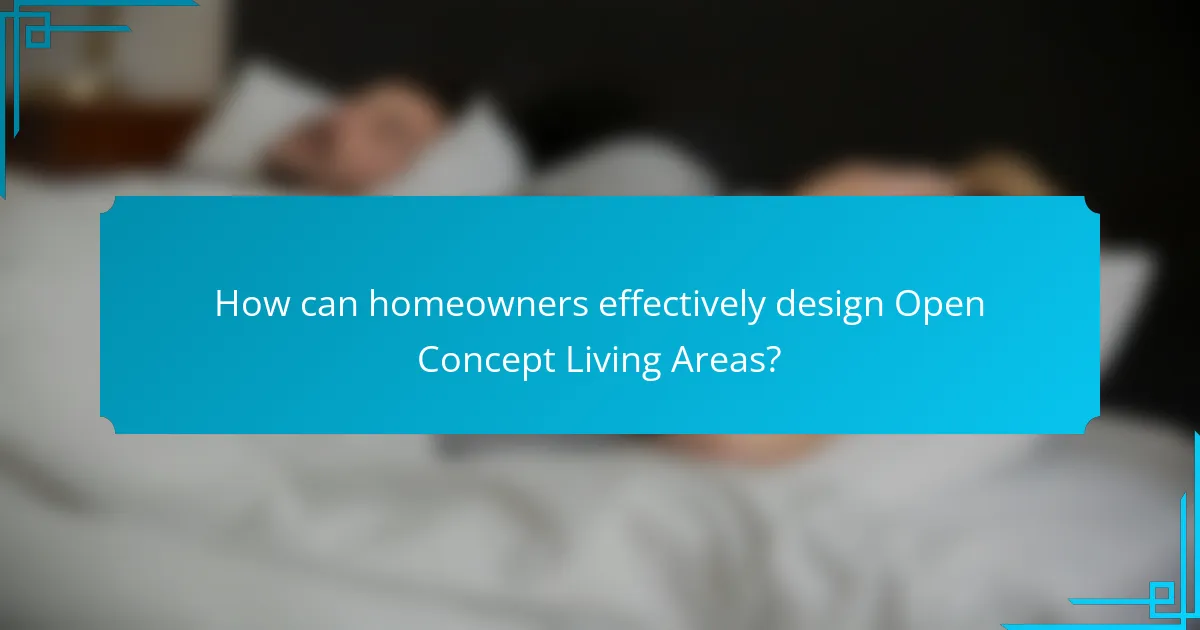Open concept living areas are designed to combine multiple functions—such as kitchen, dining, and living spaces—into a single, seamless environment without walls. This layout enhances social interaction, promotes natural light flow, and creates a perception of increased space within the home. The article explores the benefits of open concept designs, including improved mood and reduced stress levels, as well as practical strategies for homeowners to optimize layout, color schemes, and furniture for enhanced functionality and connectivity. Emphasizing the importance of flow and natural light, these design principles contribute to a cohesive and inviting living experience.

What are Open Concept Living Areas?
Open concept living areas are spaces that combine multiple functions into a single room without walls separating them. This design often merges the kitchen, dining, and living areas for a more spacious feel. Open concept layouts enhance social interaction and create a flow between different activities. They allow for more natural light to penetrate throughout the space. According to the National Association of Home Builders, open floor plans are highly sought after in modern home design. This trend reflects a shift towards more communal living environments. Open concept living areas can also increase the perceived size of a home. They are popular in contemporary architecture due to their flexibility and functionality.
Why are Open Concept Living Areas popular in modern design?
Open concept living areas are popular in modern design due to their ability to create spaciousness and enhance natural light. This layout eliminates walls between common areas, promoting a sense of flow. The open design fosters social interaction, making it easier for families and guests to connect. Additionally, it allows for flexible furniture arrangements, accommodating various lifestyles. Studies show that homes with open layouts can sell for higher prices, reflecting market demand. The style aligns with contemporary aesthetics, emphasizing minimalism and functionality. Overall, open concept living areas cater to modern living preferences, prioritizing both comfort and style.
What historical trends led to the rise of Open Concept Living Areas?
The rise of open concept living areas is primarily driven by changing social dynamics and architectural trends. In the mid-20th century, post-World War II housing booms emphasized informal living. Families sought spaces that encouraged interaction and connectivity. The popularity of modernist design also influenced open layouts. Architects like Frank Lloyd Wright promoted fluidity between spaces. Additionally, the shift towards minimalism in the late 20th century favored fewer walls and barriers. This trend was further supported by advancements in building materials, allowing for larger, unobstructed spaces. These historical factors collectively contributed to the adoption of open concept living areas in contemporary home design.
How do cultural shifts influence the design of Open Concept Living Areas?
Cultural shifts significantly influence the design of open concept living areas. Changes in lifestyle preferences drive the demand for more communal spaces. For example, the rise of remote work has increased the need for multifunctional areas that accommodate both work and leisure. Additionally, a growing emphasis on social interaction encourages designs that eliminate barriers between rooms. Trends toward minimalism also promote the use of fewer walls to create a sense of spaciousness. Urbanization has led to smaller living spaces, necessitating designs that maximize functionality and flow. These factors collectively shape how open concept living areas are conceived and executed in modern architecture.
What are the key characteristics of Open Concept Living Areas?
Open concept living areas are characterized by a lack of walls separating spaces. This design promotes an open flow between the kitchen, dining, and living areas. Natural light is maximized through large windows and unobstructed sightlines. The layout encourages social interaction and family gatherings. Multi-functional furniture is often used to optimize space. Minimalist decor is common to maintain a spacious feel. These areas often feature cohesive design elements for visual harmony. Overall, open concept living areas enhance the feeling of spaciousness and connectivity.
How does layout contribute to the flow in Open Concept Living Areas?
The layout in open concept living areas significantly enhances the flow between spaces. An open layout removes barriers, allowing for uninterrupted sightlines and movement. This design encourages interaction and connectivity among different areas, such as the kitchen, dining, and living spaces. The arrangement of furniture can further facilitate this flow by creating clear pathways. For example, placing seating in a circular arrangement promotes conversation and movement. Additionally, strategic placement of lighting can guide the eye and enhance the sense of openness. Studies show that well-designed layouts can improve social dynamics and functionality in living spaces.
What role does furniture arrangement play in enhancing space?
Furniture arrangement plays a crucial role in enhancing space by optimizing functionality and flow. Effective arrangement allows for better movement and accessibility within a room. It can create distinct areas for various activities, such as lounging, dining, or working. A well-planned layout maximizes natural light, improving the overall atmosphere. Research indicates that open layouts can increase perceived space by up to 30%. Strategic placement of furniture can also highlight architectural features, adding visual interest. Additionally, it influences social interactions by encouraging conversation and connection among occupants. Proper arrangement ultimately contributes to a more inviting and harmonious environment.
How do Open Concept Living Areas benefit from natural light?
Open concept living areas benefit from natural light by enhancing the overall ambiance and creating a more inviting space. Natural light improves mood and well-being, reducing the need for artificial lighting during the day. Studies show that exposure to natural light can increase productivity and focus. Additionally, it visually expands the space, making it feel larger and more open. The incorporation of large windows and skylights maximizes light [censured]. This design choice fosters a connection with the outdoors, promoting a sense of tranquility. Overall, natural light plays a crucial role in the functionality and aesthetic appeal of open concept living areas.
What design strategies maximize natural light in these spaces?
Incorporating large windows maximizes natural light in open concept living areas. These windows allow sunlight to penetrate deep into the space. Utilizing skylights also enhances daylight exposure. Skylights can illuminate areas that traditional windows cannot reach. Open floor plans promote light flow between rooms. This design reduces barriers that block light. Light-colored walls and ceilings reflect sunlight effectively. Reflective surfaces amplify the brightness of the space. Strategically placing mirrors can also enhance light distribution. Mirrors can redirect natural light throughout the area. Using glass doors instead of solid ones increases visibility and light access. These strategies collectively create a brighter, more inviting environment.
How does natural light impact the mood and functionality of a living area?
Natural light positively impacts the mood and functionality of a living area. It enhances psychological well-being by reducing stress and improving mood. Exposure to natural light increases serotonin levels, which can boost happiness. Furthermore, natural light enhances productivity and focus, making spaces feel more inviting. Studies show that well-lit environments can lead to better performance in tasks. Natural light also creates a sense of spaciousness, making areas feel larger. In terms of functionality, it reduces reliance on artificial lighting, leading to energy savings. Overall, natural light transforms living areas into more pleasant and efficient spaces.

What are the benefits of flow in Open Concept Living Areas?
Flow in open concept living areas enhances spatial connectivity and promotes a sense of openness. This design allows for seamless movement between spaces. It encourages social interaction among family members and guests. Natural light can easily penetrate through the entire area, creating a bright environment. Improved airflow is another benefit, contributing to comfort and ventilation. Additionally, flow can make spaces feel larger than they are. Studies indicate that open layouts can improve mood and reduce stress levels. Overall, the benefits of flow significantly enhance the living experience in open concept designs.
How does flow improve the overall living experience?
Flow improves the overall living experience by enhancing spatial connectivity and promoting a sense of harmony. Open concept designs facilitate movement and interaction among different living areas. This seamless transition reduces feelings of confinement and increases comfort. A well-designed flow allows natural light to permeate the space, creating a more inviting atmosphere. Studies indicate that exposure to natural light boosts mood and productivity. Additionally, effective flow in design can lead to improved functionality, making daily activities more efficient. This ultimately contributes to a higher quality of life in residential environments.
What are the psychological effects of open spaces on inhabitants?
Open spaces positively impact the psychological well-being of inhabitants. They promote relaxation and reduce stress levels. Access to natural light in these areas enhances mood and energy. Research shows that open spaces can improve cognitive function and creativity. A study by Kaplan and Kaplan indicates that exposure to nature fosters mental restoration. Additionally, open spaces encourage social interaction, which contributes to improved mental health. A sense of freedom and spaciousness can alleviate feelings of confinement. Overall, open spaces create an environment conducive to psychological well-being.
How can flow facilitate better social interactions in living spaces?
Flow enhances social interactions in living spaces by promoting movement and connectivity. Open layouts encourage free movement between areas. This design reduces barriers that can isolate individuals. Natural light in these spaces fosters a welcoming atmosphere. Studies show that well-lit environments improve mood and social engagement. A seamless flow allows for easier communication among occupants. It creates opportunities for spontaneous gatherings and shared activities. Overall, flow in living spaces cultivates a sense of community and belonging.
What practical considerations enhance flow in design?
Practical considerations that enhance flow in design include spatial layout, color schemes, and furniture arrangement. A well-planned spatial layout ensures that movement between areas is intuitive. Open pathways facilitate easy navigation and reduce congestion. Consistent color schemes create visual continuity, which helps connect different spaces. Harmonious color palettes can make transitions feel seamless. Additionally, furniture arrangement should promote conversation and accessibility. Arranging furniture to create clear focal points encourages interaction. Natural light plays a crucial role in enhancing flow as well. It can unify spaces and create a sense of openness. Overall, these practical considerations contribute to a cohesive and inviting environment.
How do transitions between spaces affect the overall design?
Transitions between spaces significantly influence overall design. They create a sense of flow and connectivity within open concept areas. Smooth transitions enhance movement and accessibility, making spaces feel larger and more inviting. Visual continuity, achieved through consistent materials and colors, reinforces design cohesion. Effective transitions can also guide the eye, emphasizing key design elements. Research indicates that well-designed transitions improve user experience and functionality in living spaces. For instance, a study by the American Society of Interior Designers found that fluid transitions contribute to higher satisfaction in home environments.
What role do sightlines play in creating a cohesive flow?
Sightlines are crucial in creating a cohesive flow in open concept living areas. They guide the eye through a space, enhancing visual connectivity. Effective sightlines help define areas without physical barriers. This design approach promotes an open and airy feel. Clear sightlines can improve spatial awareness and functionality. They allow natural light to penetrate deeper into the space. Well-planned sightlines can also enhance social interaction. In essence, sightlines unify different areas, making the overall design more harmonious.

How can homeowners effectively design Open Concept Living Areas?
Homeowners can effectively design open concept living areas by focusing on layout, color schemes, and functional furniture. A well-planned layout enhances flow and connectivity between spaces. Using lighter color palettes can make the area feel larger and more inviting. Incorporating multi-functional furniture allows for flexibility in usage. Clear demarcation of spaces can be achieved through area rugs or furniture arrangement. Natural light should be maximized through large windows or open access to outdoor areas. These design strategies create a cohesive and harmonious living environment.
What are the best practices for integrating natural light?
To effectively integrate natural light, maximize window placement and size. Large windows allow more light to enter. Consider south-facing windows for optimal sunlight exposure. Use skylights to bring light into spaces without exterior walls. Keep window treatments minimal to avoid obstructing light. Use reflective surfaces, like mirrors, to enhance light distribution. Choose light-colored walls and furnishings to amplify brightness. Open floor plans facilitate light flow between rooms. These practices increase energy efficiency and improve mood, as studies show natural light boosts productivity and well-being.
How can window placement optimize light and views?
Window placement can optimize light and views by strategically positioning them to capture natural sunlight and scenic vistas. Proper orientation, such as south-facing windows, maximizes daylight exposure throughout the day. This reduces the need for artificial lighting, promoting energy efficiency. Additionally, aligning windows with outdoor features enhances the visual connection to nature. The use of larger windows or glass doors can create a seamless transition between indoor and outdoor spaces. Studies show that well-placed windows can increase overall satisfaction in living environments. For instance, research indicates that natural light improves mood and productivity in residential spaces.
What types of materials enhance light reflection in these spaces?
Mirrors, glass, and metallic surfaces enhance light reflection in open concept living areas. Mirrors can reflect light effectively, doubling the brightness of a space. Glass surfaces, such as windows and doors, allow natural light to enter while reflecting it internally. Metallic finishes, like chrome or polished aluminum, bounce light around the room. Light-colored walls and ceilings also contribute by reflecting light rather than absorbing it. These materials work together to create a brighter, more open atmosphere. Studies show that reflective surfaces can increase perceived space and improve overall lighting quality.
What common mistakes should be avoided in Open Concept Living Areas?
Common mistakes in open concept living areas include poor furniture arrangement. This can lead to a cluttered space that feels disjointed. Another mistake is neglecting proper lighting. Insufficient or harsh lighting can diminish the intended ambiance. Failing to define zones can also create confusion. Distinct areas for dining, lounging, and cooking help maintain flow. Additionally, using overly large furniture can overwhelm the space. Choosing the wrong color palette may make the area feel uninviting. Lastly, ignoring acoustics can result in noise issues. Sound-absorbing materials can enhance comfort in open layouts.
How can overcrowding affect the flow and functionality?
Overcrowding can significantly disrupt flow and functionality in open concept living areas. It limits movement and creates congestion, making navigation difficult. This can lead to frustration and discomfort for occupants. When space is overcrowded, it reduces the effectiveness of the design intended to promote openness. The intended interaction and socialization benefits of an open layout are diminished. Studies show that overcrowded spaces can lead to increased stress levels among residents. For example, a study by Evans et al. (2000) found that higher density living conditions correlate with negative psychological effects. Thus, maintaining appropriate occupancy levels is essential for optimal flow and functionality.
What are the pitfalls of poor lighting design in open spaces?
Poor lighting design in open spaces can lead to several significant pitfalls. One major issue is inadequate visibility, which can create safety hazards. Poorly lit areas increase the risk of accidents, such as trips and falls. Additionally, insufficient lighting can negatively affect the aesthetic appeal of the space. It may make the area feel uninviting or cramped.
Another pitfall is the impact on mood and productivity. Studies show that well-lit environments enhance mood and focus. Conversely, dimly lit spaces can lead to feelings of fatigue and depression. Poor lighting can also obscure architectural features, diminishing the overall design intent.
Moreover, inefficient lighting design can increase energy costs. Over-reliance on artificial lighting can lead to higher electricity bills. Finally, poor lighting can deter social interactions. Spaces that are not well-lit may feel less welcoming, reducing opportunities for engagement.
What tips can enhance the design of Open Concept Living Areas?
To enhance the design of open concept living areas, focus on creating defined zones. Use area rugs to delineate spaces for different functions. Incorporate furniture arrangements that encourage conversation and flow. Utilize lighting layers, such as ambient, task, and accent lighting, to create warmth and depth. Employ color schemes that promote cohesion while allowing for variety. Implement vertical elements like shelving or plants to add dimension without obstructing sight lines. Finally, ensure ample natural light through large windows or skylights to enhance the overall ambiance. These strategies collectively improve functionality and aesthetic appeal in open concept designs.
Open concept living areas are designed to combine multiple functions within a single space, promoting social interaction and maximizing natural light. This article explores the benefits of open layouts, including their historical context, cultural influences, and key characteristics that enhance flow and functionality. It discusses practical design strategies for integrating natural light and optimizing furniture arrangement to improve mood and social dynamics. Additionally, common pitfalls in lighting and overcrowding are addressed, providing homeowners with actionable tips for creating inviting and efficient living environments.